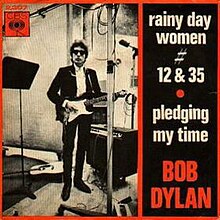Rainy Day Women No. 12 & 35
| "Rainy Day Women #12 & 35" | ||||||||||||
|---|---|---|---|---|---|---|---|---|---|---|---|---|
 |
||||||||||||
| Single by Bob Dylan | ||||||||||||
| from the album Blonde on Blonde | ||||||||||||
| B-side | "Pledging My Time" | |||||||||||
| Released | April, 1966 | |||||||||||
| Format | 7" | |||||||||||
| Recorded | March 10, 1966 | |||||||||||
| Genre | Folk rock, blues rock, jazz | |||||||||||
| Length | 4:36 (album version) 2:26 (single edit) |
|||||||||||
| Label | Columbia | |||||||||||
| Writer(s) | Bob Dylan | |||||||||||
| Producer(s) | Bob Johnston | |||||||||||
| Bob Dylan singles chronology | ||||||||||||
|
||||||||||||
|
||||||||||||
| 14 tracks |
|---|
|
"Rainy Day Women #12 & 35" is a song by Bob Dylan. It is the opening track of his 1966 album, Blonde on Blonde. It was initially released as a single in April 1966, reaching No. 7 in the UK and No. 2 in the US chart. "Rainy Day Women", recorded in the Nashville studio of Columbia Records, features a raucous brass band backing track. The song's title does not appear anywhere in the lyrics and there has been much debate over the meaning of the recurrent chorus, "Everybody must get stoned". This has made the song controversial, being labelled by some commentators as "a drug song".
The song is notable for its brass band arrangement and the controversial chorus "Everybody must get stoned". Al Kooper, who played keyboards on Blonde on Blonde, recalled that when Dylan initially demoed the song to the backing musicians in Columbia's Nashville studio, producer Bob Johnston suggested that "it would sound great Salvation Army style. When Dylan queried how they would find horn players in the middle of the night, Charlie McCoy, who played trumpet, made a phone call and summoned a trombone player.
The song is essentially a simple blues chord progression in the key of F. The parts played by the trombone, tuba, piano, bass, drums, and tambourine remain practically the same in all of the verses. Much laughter and shouting in the background accompanies the song, mixed down to a low volume level, and Dylan laughs several times during his vocal delivery.
The track was recorded in Columbia Music Row Studios in Nashville in the early hours of March 10, 1966. In the account of Dylan biographer Howard Sounes, the chaotic musical atmosphere of the track was attained by the musicians playing in unorthodox ways and on unconventional instruments. McCoy switched from bass to trumpet. Drummer Kenny Buttrey set up his bass drum on two hard-back chairs and played them using a timpani mallet. Moss played bass, while Strzelecki played Al Kooper's organ. Kooper played a tambourine. Producer Bob Johnston recalled, "all of us walking around, yelling, playing and singing."
...
Wikipedia
